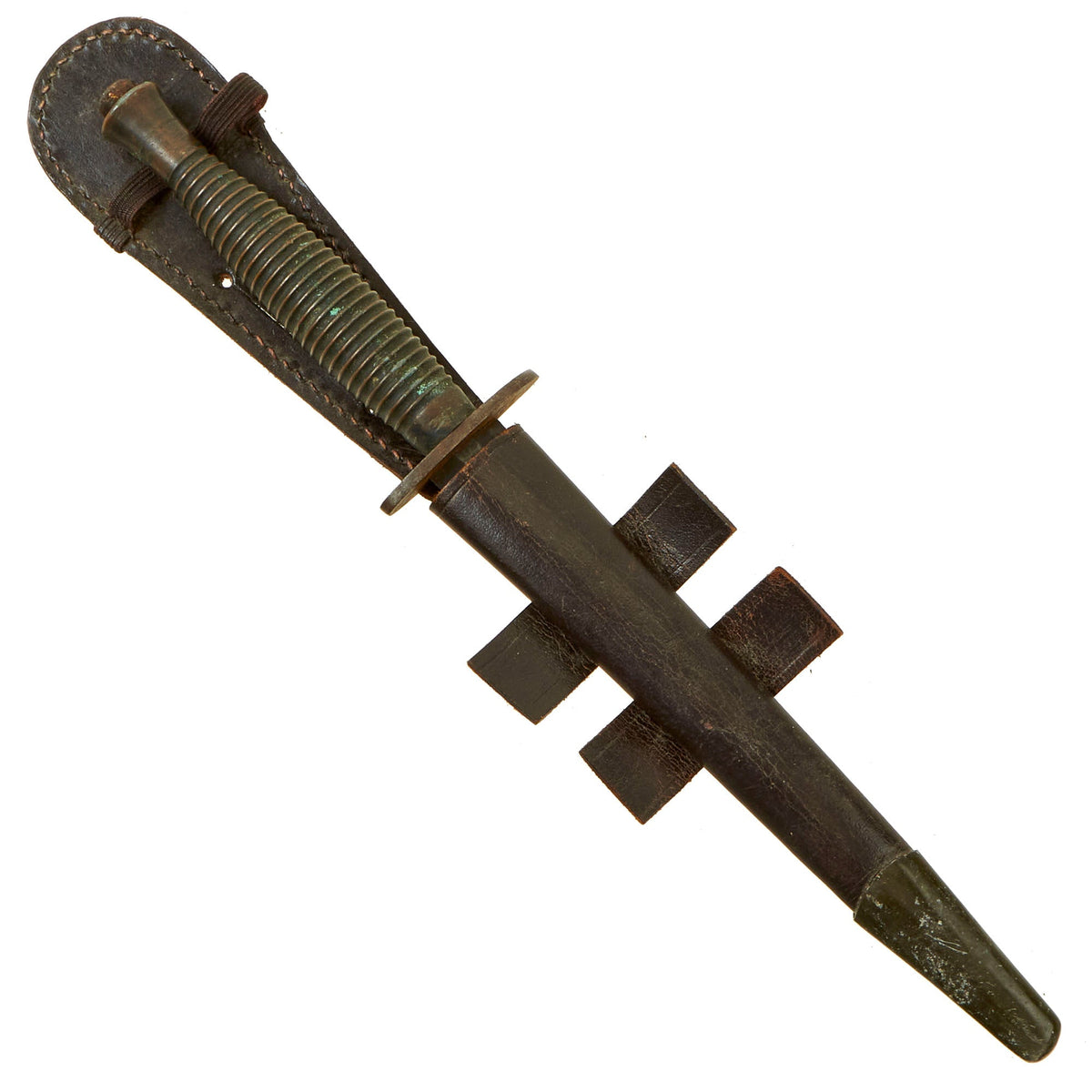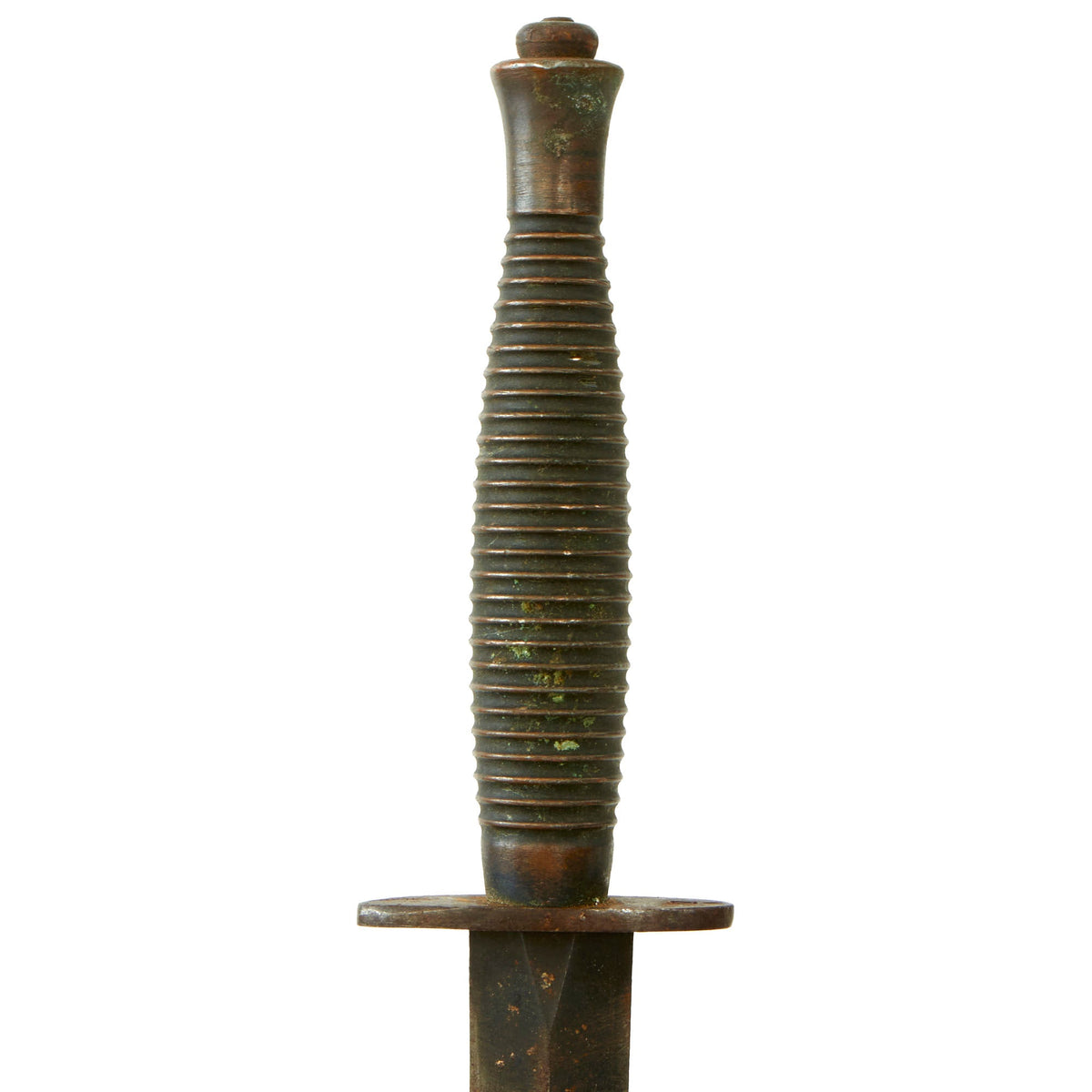Original British WWII Early Third Pattern Fairbairn-Sykes Fighting Knife with FR271 Scabbard – Broad Arrow Marked Original Items
$ 595,00 $ 178,50
Original Item: Only One Available. This is an excellent example of an early “Third Pattern” British Fairbairn-Sykes commando dagger, with a Copper coated alloy handle and original scabbard.
As brass was a “strategic material,” only the early examples of the third pattern have brass handles, with later war produced models having alloy handles. The handle dates production to late 1943 – early 1944. The knives varied somewhat in size, and this example measures 11 5/8″, with a 7 inch blade. This example comes with the original standard F/S Scabbard, with elastic at the top, though the elastic shows signs of deterioration.
Condition of the knife is good, still with sharp edges, and almost 50 percent of the finish and a light coating of oxidation. The plain blued steel cross guard still retains some of the finish, and is marked on the underside of the grip with “ENGLAND” which was done for importation purposes. The handle is overall very good with little of the original black finish in the recesses of the grip.
The scabbard is nice, but does show signs of age to the leather, although it is still pliable. From the looks of it, this knife spent most of its life in a scabbard, and saw minimal, if any, use during WWII.
An increasingly hard to find knife that would fit into any WWII Collection!
Dimensions:
Blade length: 6 15/16”
Blade Style: Spear Point Knife
Overall length: 11 3/4”
Crossguard: 2”
Scabbard length: 7 1/2″ + belt loop
History of the FS British Commando Dagger:
The demand for a good fighting knife was so very urgent that a meeting was arranged in November 1940 between W. E. Fairbairn, E. A. Sykes and Jack Wilkinson Latham at Wilkinson Sword Company.
Fairbairn and Sykes described the type of knife they envisioned and the purpose for which it was intended. As discussion continued, preliminary sketches were drawn up and modified time and time again.
As Robert Wilkinson Latham tells it: ‘In order to explain exactly their point, the two men rose to their feet and one, it was Fairbairn my grandfather mentioned, grabbed the wood ruler from his desk and the two men danced around the office in mock combat’.
The very first 1st Pattern F-S Fighting Knives were made in November 1940. In January 1941, the full war full production started, according to Robert Wilkinson Latham.
The grip was made from solid brass and cut by 16 lines per inch in a diamond pattern. The grip and hand guard were nickel plated. The hand guard was curved to S-shape.
The blade was grounded by hand. For this reason it is difficult to find two blades of exactly the same size and shape. This model was produced in very limited numbers.
The very first 1st Pattern Wilkinson Sword F-S knives were ordered the 14th of November 1940. Order 294 mentions 500 ‘RBD and Commercial knives’ but possibly less. They were called in this way in the order to disguise the actual type of knife.
The 1st Pattern was delivered from November 1940 until April 1941. 17th of December 1940 5000 “hunting knives” were ordered. This order concerned the first 1st Pattern knives. Price for each was 13 s 6d. All together 6 779 – 1st pattern were made according to Robert Wilkinson Latham.
In 1941 to speed production, the design was simplified and it was called the ‘New Pattern’ in Wilkinson Sword Contract Book and Pall Mall Works Orders, which is now called the 2nd Pattern. The blade was still drop forged and hand ground, but without special square ricasso. The hand guard was no longer curved, though otherwise the grip remained the same. This pattern was made between 12th of August 1941 until the end of 1943.
Originally, these were nickel-plated as the First pattern knives had been, but as production increased, the blade was left bright steel, and the grip was instead blackened. After 6th of February 1943, the blade was also finished black, so the entire knife was now black.
Markings were also minimized to reduce production time, so often the only markings would be the broad arrow proof on the grip.
Fast Shipping with Professional Packaging
Thanks to our longstanding association with UPS FedEx DHL, and other major international carriers, we are able to provide a range of shipping options. Our warehouse staff is expertly trained and will wrap your products according to our exact and precise specifications. Prior to shipping, your goods will be thoroughly examined and securely secured. We ship to thousands clients each day across multiple countries. This shows how we're dedicated to be the largest retailer on the internet. Warehouses and distribution centres can be located throughout Europe as well as the USA.
Note: Orders with more than one item will be assigned a processing date depending on the item.
Before shipping before shipping, we'll conduct a thorough inspection of the items you have ordered. Today, the majority of orders will be delivered within 48 hours. The delivery time will be between 3-7 days.
Returns
The stock is dynamic and we cannot completely manage it because multiple stakeholders are involved, including our factory and warehouse. So the actual stock may alter at any time. It's possible that you may not receive your order once the order has been made.
Our policy is valid for a period of 30 days. If you don't receive the product within 30 days, we are not able to issue a refund or an exchange.
You can only return an item if it is unused and in the same state as the day you received it. You must have the item in its original packaging.
Related products
Uncategorized
Uncategorized
Uncategorized
Uncategorized
Band of Brothers ORIGINAL GERMAN WWII Le. F.H. 18 10.5cm ARTILLERY PIECE Original Items
Uncategorized
Uncategorized
Uncategorized
Australian WWII Owen MK1 Machine Carbine SMG Custom Fabricated Replica with Sling Original Items
Uncategorized
Uncategorized
Uncategorized
Armoured Fighting Vehicles of the World: AFVs of World War One (Hardcover Book) New Made Items
Uncategorized
Uncategorized
Uncategorized
Uncategorized
Uncategorized
Uncategorized
Uncategorized
Angolan Rebel 1970s era 60mm Inert Display Mortar from Angolan Civil War Original Items
Uncategorized
Uncategorized












































































